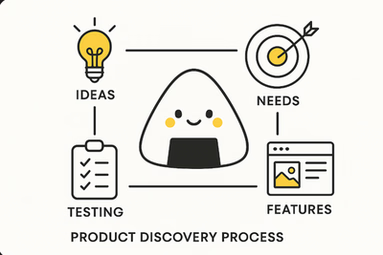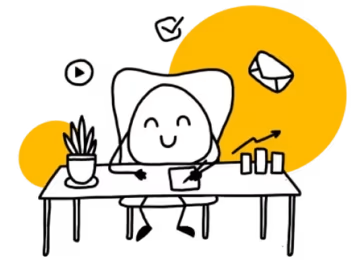.png)
Product Discovery Process: Build Features Users Actually Need
Master the product discovery process with proven frameworks. Learn user research techniques, validation methods, and avoid building unwanted features.

Product Discovery Process: Build Features Users Actually Need
The brutal truth about product development? 70% of features are rarely or never used by customers. That's not a typo - it's a wake-up call from Microsoft's extensive product usage data. Yet product teams continue building features based on assumptions, stakeholder opinions, and "brilliant" brainstorming sessions that happen in conference rooms far removed from actual users.
The antidote? A structured product discovery process that transforms guesswork into evidence-based decisions. Whether you're a seasoned product manager drowning in feature requests or a startup founder trying to achieve product-market fit, mastering discovery is your secret weapon for building products that users genuinely need and love.
What Is Product Discovery and Why It's Critical for Product Success
Product discovery is the investigative phase where assumptions die and user truth emerges. Unlike traditional market research that asks users what they want (spoiler: they don't always know), discovery uncovers the underlying problems, behaviors, and contexts that drive real user needs.
Think of it as detective work for product managers. You're not just collecting feedback - you're uncovering the "why" behind user behaviors, the emotional triggers that drive decisions, and the unspoken frustrations that represent your biggest opportunities.
The cost of skipping discovery is staggering:
- Features that miss the mark require 3x more resources to fix than validate upfront
- Poor product-market fit is the #1 reason startups fail (42% according to CB Insights)
- Teams spend months building solutions to problems that don't actually exist
The Complete Product Discovery Framework
Phase 1: User Research That Goes Beyond Surface-Level Feedback
The Foundation: Strategic User Interviews
Most product teams conduct interviews wrong. They ask leading questions, focus on features instead of problems, and miss the emotional context that drives user behavior. Here's how to do it right:
Essential Interview Techniques:
- Start with behavior, not opinions
- Ask: "Walk me through how you currently solve this problem"
- Instead of: "What features would you like to see?"
- Dig into emotional triggers
- "Tell me about the last time this problem really frustrated you"
- "How does this impact your day/work/goals?"
- Explore workarounds and substitutes
- "What tools or methods do you currently use?"
- "How do you get around this limitation today?"
Pro tip: Record interviews (with permission) and create a shared repository. Patterns emerge when you can analyze multiple conversations together, not just individual feedback sessions.
Phase 2: Data-Driven Problem Validation
User interviews reveal what people say, but behavioral data shows what they actually do. This gap between stated preferences and actual behavior is where breakthrough insights live.
Key Metrics to Track During Discovery:
- Task completion rates: How often do users successfully complete core workflows?
- Time to value: How long before users experience meaningful outcomes?
- Drop-off points: Where do users abandon processes or features?
- Usage frequency: Which problems occur daily vs. occasionally?
Real-World Example:A SaaS company discovered through interviews that users wanted more customization options. However, usage analytics revealed that 80% of users never modified default settings. The real problem? The default setup didn't match their workflow needs, not a lack of customization features.
Phase 3: Problem Hypothesis Formation
Transform scattered insights into testable hypotheses. This isn't about being right - it's about learning fast and failing cheap.
Hypothesis Framework:"We believe that [specific user segment] experiences [specific problem] when [specific context/situation] because [underlying reason], which leads to [negative outcome]."
Example:"We believe that freelance consultants experience difficulty tracking project profitability when managing multiple clients because existing tools require manual data entry across different systems, which leads to underpricing projects and reduced income."
Phase 4: Rapid Validation Techniques
Before building anything, validate your hypotheses with minimal investment. Here are proven validation methods ranked by speed and cost:
Low-Cost Validation Methods:
- Prototype Testing: Create clickable mockups to test user comprehension and workflow
- Landing Page Tests: Measure interest with fake doors and signup rates
- Wizard of Oz Testing: Manually fulfill the service behind an automated-looking interface
- User Journey Mapping: Observe users completing tasks with current tools
Validation Success Metrics:
- Define clear success criteria before testing (e.g., "60% of users complete the core workflow without assistance")
- Set failure thresholds that trigger pivot decisions
- Establish timeline boundaries (validate within 2-4 weeks, not months)
Common Product Discovery Pitfalls and How to Avoid Them
Pitfall #1: Confusing User Requests with User Needs
The Problem: Users ask for faster horses instead of cars. They request solutions based on their current context, not underlying needs.
The Fix: Always ask "What problem are you trying to solve?" when users suggest features. Dig into the job-to-be-done behind their request.
Pitfall #2: Interviewing Only Existing Users
The Problem: Current users represent one segment. You miss insights from non-users, churned users, and potential users who might need your product differently.
The Fix: Interview across the user spectrum: power users, occasional users, churned users, and people who chose competitor solutions.
Pitfall #3: Analysis Paralysis
The Problem: Endless research without decision-making leads to delayed launches and missed market opportunities.
The Fix: Set research time boxes and decision deadlines. Aim for 80% confidence, not 100% certainty.
Implementing Discovery in Agile Product Development
Discovery isn't a separate phase - it's an ongoing discipline that runs parallel to development. Here's how to integrate discovery into your product roadmap planning:
Continuous Discovery Model:
- Week 1-2: Identify and validate problems
- Week 3-4: Prototype and test solutions
- Week 5-6: Build and measure outcomes
- Repeat: Each cycle builds on previous learnings
Cross-Functional Collaboration:
- Include engineers in user interviews to build empathy
- Involve designers in problem definition, not just solution creation
- Engage customer success teams who hear user feedback daily
Measuring Discovery Success: Beyond Vanity Metrics
Track metrics that matter for long-term product success:
Leading Indicators:
- Problem validation confidence scores
- User interview insights per week
- Hypothesis testing velocity
Lagging Indicators:
- Feature adoption rates post-launch
- Customer satisfaction improvements
- Reduced feature development waste
Transform Your Product Strategy with Evidence-Based Discovery
Product discovery isn't just a research phase - it's a competitive advantage. Teams that master discovery build products that users love, achieve stronger product-market fit, and waste fewer resources on unwanted features.
The framework outlined here provides a systematic approach to understanding user needs, validating problems, and building solutions that matter. But implementation requires discipline, cross-functional collaboration, and organizational commitment to evidence over opinions.
Ready to transform your product development process? ProductPeople helps product teams implement discovery frameworks that accelerate time-to-market while reducing development waste. Our experienced product consultants work with your team to establish sustainable discovery practices that drive measurable business outcomes.
Contact Product People today to discuss how we can help your team build products that users actually need - not just products you think they want.
FAQ
Product discovery is the essential first phase of product development where you investigate and validate user problems, needs, and behaviors. It’s critical because it prevents teams from building features based on assumptions. By uncovering the "why" behind user actions, discovery ensures you build products that users genuinely need and will actually use.
Traditional market research often asks users what they want, which can lead to misguided solutions (e.g., users asking for "faster horses" instead of cars). Product discovery, on the other hand, is like detective work. It focuses on understanding underlying user problems, behaviors, and emotions to uncover the real needs and opportunities.
This statistic comes from Microsoft and serves as a powerful wake-up call. It means that a significant majority of features built by product teams either don't solve a real problem or fail to resonate with users. This highlights the immense waste of time, resources, and effort that results from skipping a proper product discovery process.
Read More Posts
.png)
Product-Led Growth: Is It Right for Your Company?
.png)
Best Practices for Technical Product Development
.png)
Product Pricing Framework & Strategy Guide
.png)
Lessons on Resource Allocation for Product Teams
.png)
Are your Products Agile enough for the Holiday Season?
.png)


